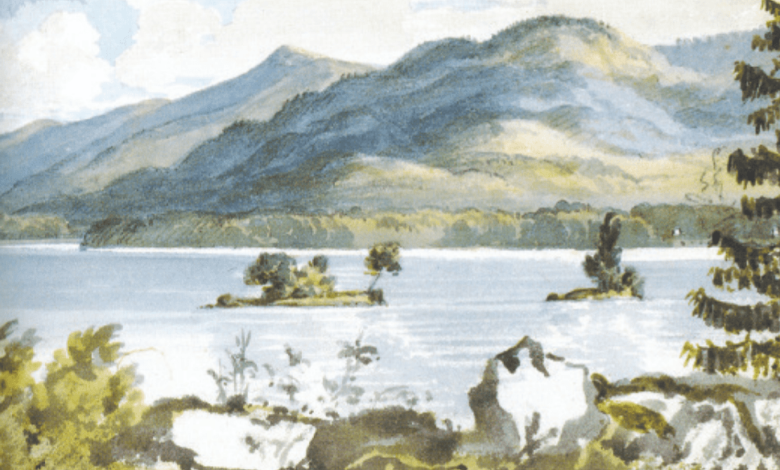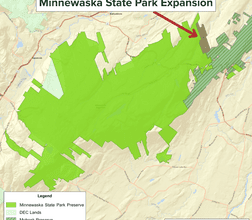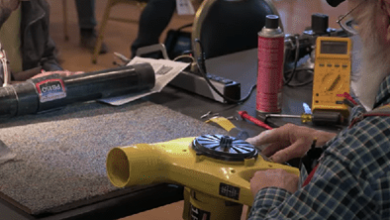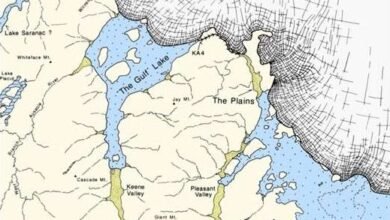The Lake George Trip That Inspired ‘Last of the Mohicans’


 James Fenimore Cooper’s knowledge of the French and Indian War may have been sketchy, but he was interested enough in its history to contemplate a visit to Lake George, which he finally did with a party of Englishmen in August, 1824.
James Fenimore Cooper’s knowledge of the French and Indian War may have been sketchy, but he was interested enough in its history to contemplate a visit to Lake George, which he finally did with a party of Englishmen in August, 1824.
Lord Edward Stanley (1799-1869), who would later become the 14th Earl of Derby and thrice Great Britain’s Prime Minister during the reign of Queen Victoria, was the leader of that party. His account of the visit to Lake George was committed to his journals, portions of which were published in 1930 in a limited edition of fifty copies commissioned by his grandson.
Much of it is now included in A North American Tour Journal 1824–1825: The Making of a Prime Minister, which was published last month in the U.S. in a version edited by the wife of the 19th Earl.

 The future 14th earl of Derby departed England under a cloud. His political career was off to a rocky start, and he was in love with a woman he was forbidden to marry. The lengthy tour of America that he was about to embark upon — a “banishment,” as he called it — had been imposed upon him.
The future 14th earl of Derby departed England under a cloud. His political career was off to a rocky start, and he was in love with a woman he was forbidden to marry. The lengthy tour of America that he was about to embark upon — a “banishment,” as he called it — had been imposed upon him.
From July 1824 into March 1825, Stanley traveled throughout the U.S. and Canada, accompanied by three old friends from Christ Church, Oxford, who, like him, were members of Parliament, two servants and, for a time, his dog Rover. Stanley, friends, servants and Rover reached Lake George on August 8, less than a month after arriving in New York.
As they crossed the Hudson River at Glens Falls, “an American novelist who was of our party on that occasion was much struck with the scenery which he had not before seen before and exclaimed, ‘I must place one of my old Indians here.’” The American novelist was, of course, James Fenimore Cooper.
According to an account written later by Cooper’s daughter, Susan Fenimore Cooper, the group left the stagecoach and by way of a wooden staircase, descended to the caves below the bridge, where Stanley reportedly told Cooper that “here was the very scene for romance.”
Susan Cooper added, “Some pleasantry passed between them and James Fenimore Cooper promised that a book should actually be written in which these caves have a place.”
That book was written and published two years later as Last of the Mohicans. As James A. Holden, New York State’s official historian in the early 1900s, would later write, the novel “affixed to the cave an undying fame, so that for nearly a century it has been a visiting place for European and American travelers, for scientist and layman, for geologist and artist, for seekers after the unusual.”
It is likely that the Englishmen met Cooper for the first time at Saratoga Springs, where Stanley and his friends they had gone to drink the waters and observe a social scene comprising “families from all parts of this vast Union,” including Southerners escaping “pestilential summers.”
“We stayed but a few days at Saratoga and then set out upon a little excursion to Lake George,” Stanley wrote, adding parenthetically that they were not far from “the battleground of Saratoga, where General John Burgoyne’s army was compelled to surrender.” His great-great aunt, Charlotte Stanley, was married to Burgoyne.
After attending a church service in Saratoga and “an intensely hot” day of travel, the party reached Lake George late in the evening.
As the purpose of the visit was to explore the scenes of the French and Indian Wars, “the little excursion” could not help but have provided Cooper with material that he could make use of later when writing Last of the Mohicans.
A climb up Prospect Mountain, for instance, could have inspired this scene from the beginning of the novel: “To the north stretched the limpid, and, as it appeared from this dizzy height, the narrow sheet of the ‘holy lake,’ indented with numberless bays, embellished by fantastic headlands, and dotted with countless islands… Directly on the shore of the lake, lay the extensive earthen ramparts and low buildings of William Henry.”
![]()
![]() And, as a matter of fact, the group did examine “old” forts, “some of the Revolutionary War, others in earlier times against the Indians, in which are collected as relics buttons, bullets, tomahawks, etc.,” as Stanley wrote.
And, as a matter of fact, the group did examine “old” forts, “some of the Revolutionary War, others in earlier times against the Indians, in which are collected as relics buttons, bullets, tomahawks, etc.,” as Stanley wrote.
(According to the editors of Stanley’s journals, the “old forts” were, in all likelihood, the ruins of Fort William Henry, Fort George and Fort Ticonderoga.)
Gazing upon these ruins, Cooper could easily have started composing in his head the novel’s first lines:
“It was in this scene of strife and bloodshed that the incidents we shall attempt to relate occurred, during the third year of the war which England and France last waged for the possession of a country that neither was destined to retain.”
Cooper, Stanley and their party stayed at the Lake House, the present site of Shepard Park in the village of Lake George. Built in 1801, the hotel had piazzas facing both the lake and the street. Lawns sloped gradually to the lake’s edge, where steamboats landed, and an orchestra played in a summer house constructed on the docks.

 “From the Lake House, fronting the water, a comprehensive view of the historic grounds may be seen. In the distance is French Mountain. By the trees on the shore is the site of Fort William Henry; and further on the left, is the site of Fort George,” a later visitor noted.
“From the Lake House, fronting the water, a comprehensive view of the historic grounds may be seen. In the distance is French Mountain. By the trees on the shore is the site of Fort William Henry; and further on the left, is the site of Fort George,” a later visitor noted.
Like Cooper, Stanley was interested in the history of Britain’s wars on the North America continent, and according to the journals, the two discussed, among other things, the secret agent who was the model for patriot Harvey Birch in Cooper’s 1821 novel The Spy; a Tale of Neutral Ground.
Also, from the piazza of the Lake House, they could have looked out upon the scenes of 18th century warfare, from Montcalm’s siege of Fort William Henry to Abercrombie’s departure from Fort George for Carillon.
The hotel “is beautifully situated and from hence a steamboat plies to the neighborhood of Fort Ticonderoga,” wrote Stanley. On one of the three or four days of their visit, the group boarded the Mountaineer for a voyage down the lake, where they passed “immense forests on the banks… almost unbroken.”
In fact, much of the description of natural scenery, which is as important a part of the novel as the narrative and the characters, was in all likelihood based on impressions Cooper received during that cruise down the lake.
With the publication of Last of the Mohicans in 1826, heritage tourism on Lake George began in earnest.
George Washington visited the ruins of Fort George, Fort William Henry and Fort Ticonderoga in 1783, followed by Thomas Jefferson and James Madison in 1791.
But it was Cooper and a party of Englishmen who truly got the ball rolling.
A version of this article first appeared on the Lake George Mirror, America’s oldest resort paper, covering Lake George and its surrounding environs. You can subscribe to the Mirror HERE.
Illustrations, from above: A watercolor of Lake George, painted by Captain Joshua Rowley Watson, an English traveler who visited Lake George a few years before James Fenimore Cooper; Edward Geoffrey Stanley by Sir George Hayer, 1825; An early view of the ruins of Fort Ticonderoga; and a portrait of Cooper painted in 1822, two years before he met Stanley, by John Wesley Jarvis (Fenimore Art Museum).
Source link



